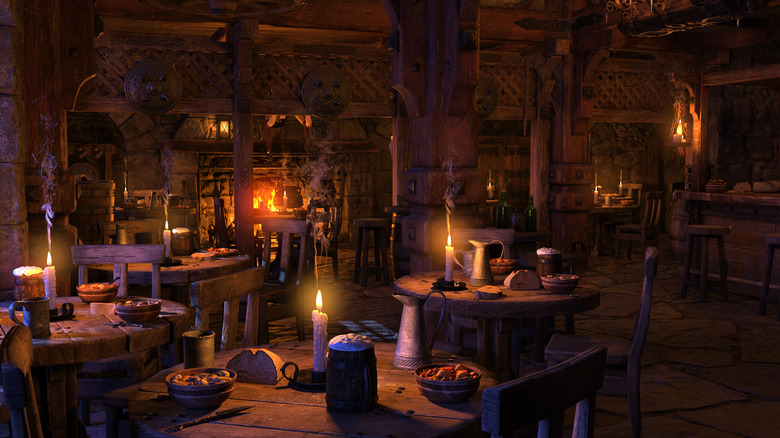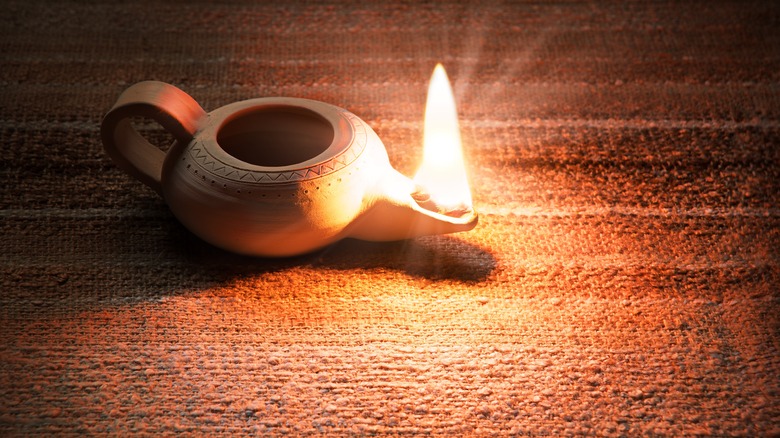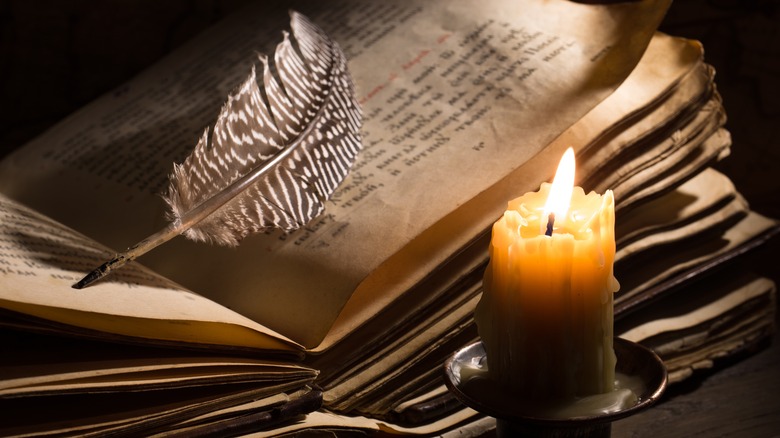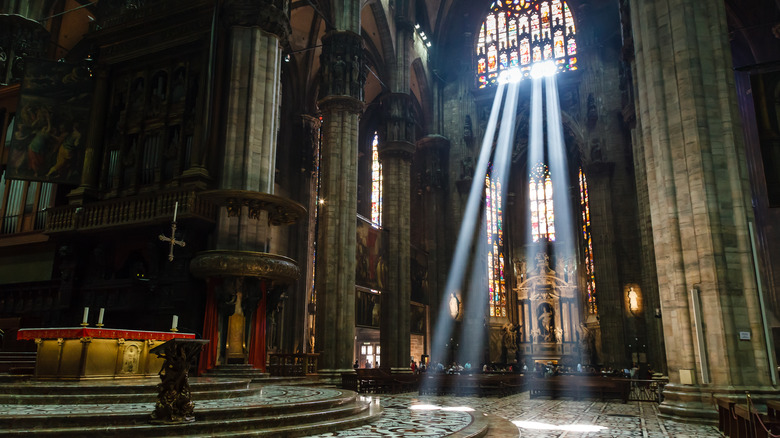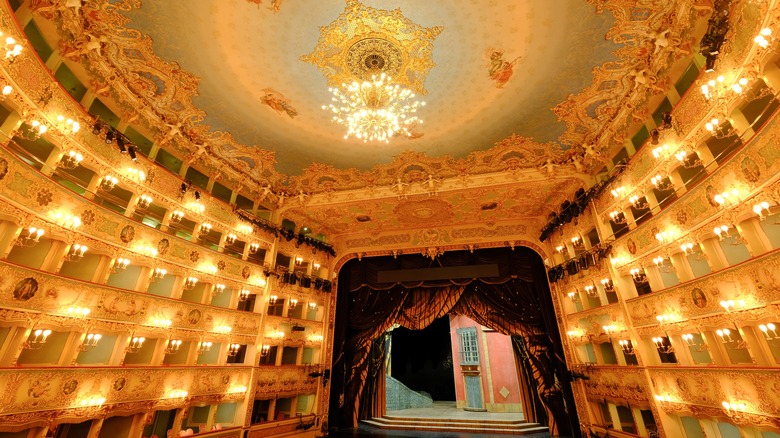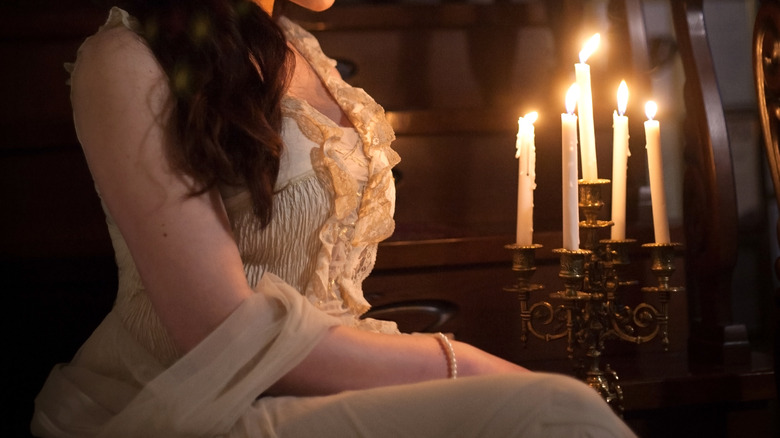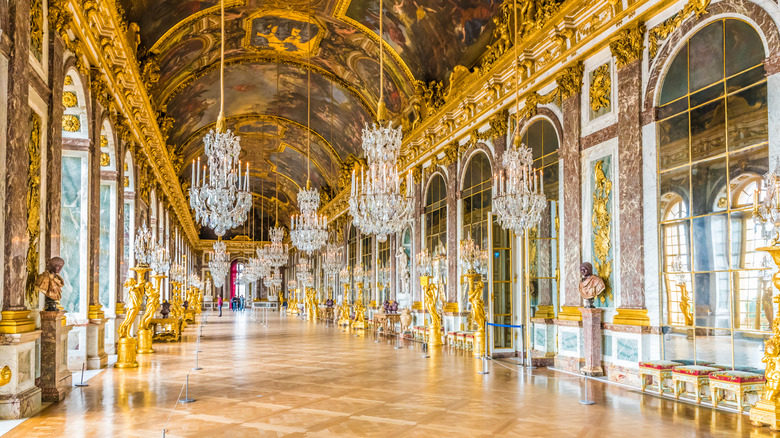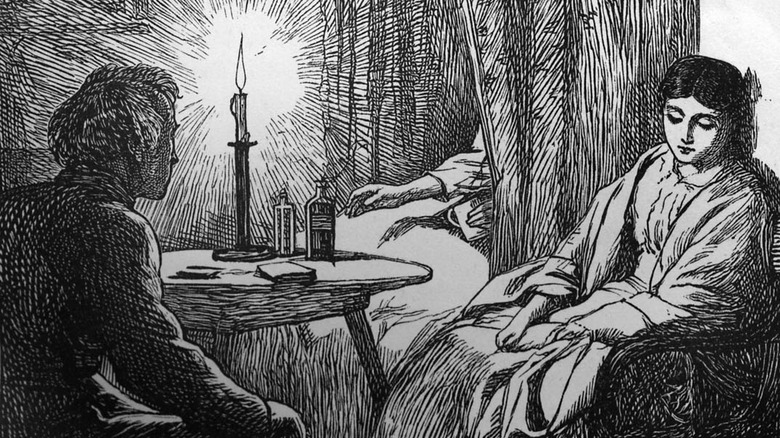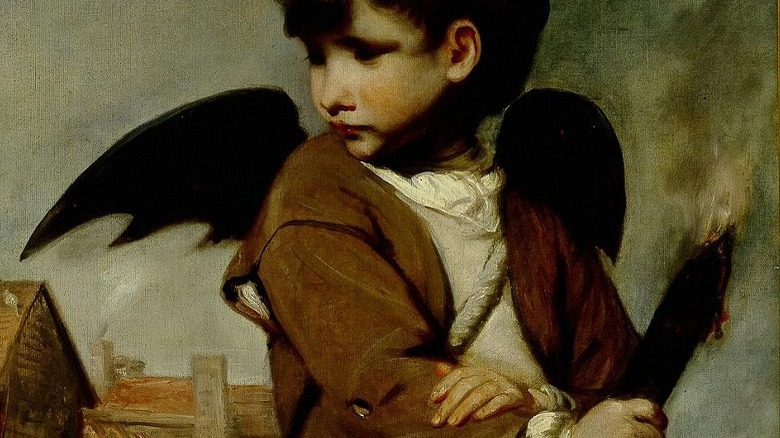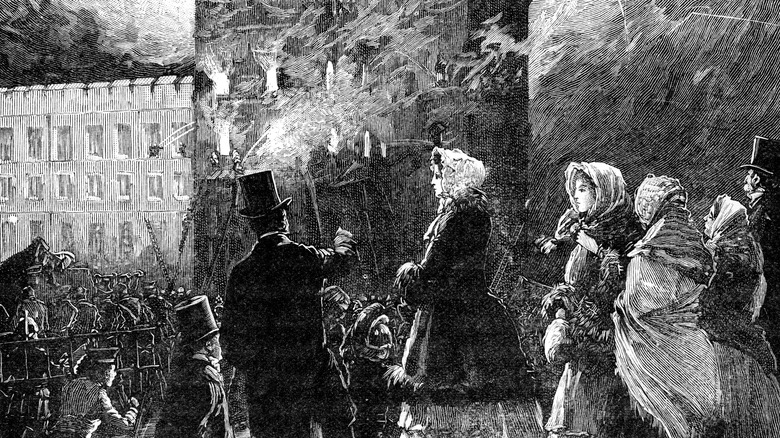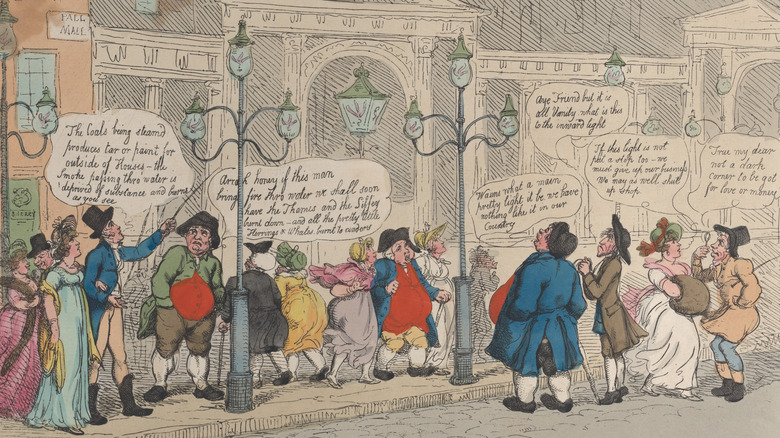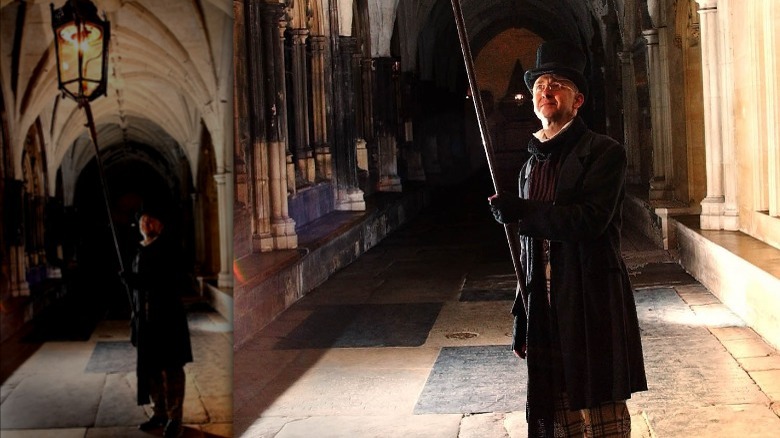What Cities Looked Like Before Electricity Was Discovered
Electricity is easy to take for granted in our modern world, but electric lighting hasn't been around for that long. It was only a few hundred years ago that we were relying on candles and finally gas lights to push back the darkness.
Our homes, cities, towns, and villages were dark for so long that some psychologists think that it helped humans evolve their fear of the dark. Ryerson University professor of psychology Martin Antony explained to CNN that for thousands of years, the darkness has been full of horrible, terrible things that want to kill us, and "Fear is there to protect us from possible harm. ... In the dark, our visual sense vanishes, and we are unable to detect who or what is around us. ... Being scared of the dark is a prepared fear."
There was a lot to be afraid of, from prehistoric predators to Victorian-era gangs who would roam the night and prey on the unsuspecting. But there was a flip side to it, too: As historian Roger Ekirch told The Guardian, "Large numbers of people came up for air when the sun went down. It afforded them the privacy they did not have during the day." The night was the domain of servants and serfs, of the ordinary worker, and of the off-limits lovers. This combination of fear and freedom means that the landscape of the pre-electricity night was a fascinating tale. Here's what cities looked like before electricity was discovered.
Production of ancient oil lamps was a massive industry
Oil lamps illuminated cities for hundreds of years. A 1980 study called "Roman Terracotta Lamps: The Organization of an Industry" lamented that there were so many that had been found that it simply wasn't possible to catalog them all.
The need for light shaped not only cities but industry — and it's been like that for literally thousands of years. In 2022, The Jerusalem Post reported on the discovery of a largely intact oil lamp that was estimated to be around 2,300 years old, and what's really surprising is how long it remained unchanged. The Israel Antiquities Authority reported (via The Times of Israel) that similar designs were discovered when archaeologists unearthed a 1,600-year-old oil lamp workshop. Interestingly, oil lamps are thought to be one of the world's oldest mass-produced goods.
In 2008, Discovery News talked to Italian archaeologists who were excavating a city that was at the center of the Roman world's oil lamp production (via NBC News). Located in what's now Modena, the site was found to have workshops where a variety of brands — with names like Fortis, Phoetaspi, and Strobili — were manufactured. Oil lamp manufacturing was a critical profession for hundreds of years, and the products these artisans made were one of the first pirated items, too. Particular brands were highly sought-after status symbols, and even then, makers' marks were faked.
Even candles were shockingly dim
The National Candle Association says that for 5,000-odd years, humankind has been making candles with everything up to and including cinnamon tree fruits, insects, and tree nuts. By the Middle Ages, the candles of the wealthy (and the church) were made of beeswax, while others were created with tallow. And that actually led to something surprisingly odd.
According to Charles Adler, author of "Wizards, Aliens and Starships: Physics and Math in Fantasy and Science Fiction" (via Medievalists), the light that comes from a candle is different than what's put out by our modern lightbulbs. "Only about 1% of the light from the candle is radiated away in [the] visible region of the spectrum, compared to about 10% of the light from the bulb." Direction and strength are important, too, and it means that someone in the Middle Ages was trying to read by a candle that was about 80 times dimmer than modern electric lights.
That's had a few interesting side effects, starting with the use of the gold leaf. That actually wasn't popular because it was pretty or looked expensive: Instead, it was popular because it was easier to see in the dimly lit nighttime hours. A fascinating 2013 study published in I-Perception went one step further and found that when medieval paintings were illuminated specifically and only with beeswax candlelight, entirely new shadows emerged and suggested the dim lighting of medieval candles influenced artists on a largely unstudied technical level.
Natural light helped shape the layouts of churches and cathedrals
Massive monuments like Stonehenge were famously aligned with the sun's movement across the skies. It wasn't just a pagan practice, and the need to harness natural light in order to illuminate sacred spaces shaped the construction of potentially gloomy Christian churches.
Medieval art historian Alice Isabella Sullivan says (via Medievalists) that with no other way to illuminate the dark, cavernous spaces within early churches, many were laid out in such a way that guaranteed the rising sun would shine first through a window that would cast light on the altar before any other interior space.
There are tons of examples of this across Europe, but she points to Romania's Holy Cross at Patrauti Monastery as one of the most stunning examples. Built in the 15th century, the church was aligned in such a way that on the weeks around the equinoxes, light — symbolizing Christ — falls along the length of the church and hits the altar at times traditionally reserved for the most devout of prayers. There's also a mural of St. Auxentius on onev wall of the church, and a carefully placed window allows a beam of sunlight to stream onto his image on his feast day. Other saints are similarly illuminated, and even more impressive are a series of carefully placed windows and murals that — over the course of 30 days — shine down in a pattern that tells the story of St. John the Baptist.
Plays and operas were written with lighting in mind
Composers creating moving works designed to be performed in Europe's theaters and palaces had to work within some surprising confines — and it all had to do with light.
Research done by NPR's Susan Stamberg uncovered some fascinating trivia about the development of — in particular — 17th-century operas. At the time, opera houses and theaters were lit by massive chandeliers and hundreds of candles, but given that performances could last for hours and those candles would get very, very hot, they would have to be replaced at some point. Instead of interrupting the flow of the story, the opera, or the concert, composers and playwrights would take candle replacement times into account.
And that meant things got very specific: The main acts of the play would be between 33 and 39 minutes long and were typically book-ended by a prologue and a final act that were about 25 minutes long. That meant they had time to get settled, sit through a prologue and a first act, then wait for the candles to be replenished. By the time the candles burned down again — which took about an hour — they'd squeeze in the next two acts ... and so on, and so on, until everything was wrapped up quickly enough to ensure that there was still enough time left on the candles to allow everyone to make their way out.
Women's clothing presented terrible risks
One of the great things about turning on a light bulb is not having to really worry about a mild breeze setting people on fire ... because pre-electricity, that's exactly what happened.
What's going on here is actually twofold, according to "Ballerina: Sex, Scandal, and Suffering Behind the Symbol of Perfection" by author Deirdre Kelly. She explained to Racked that throughout the 19th century, not only were homes, theaters, and all the fashionable hangout spots lit by a combination of candles, open flames, and gas lights, but new advances in mass production meant that more women had access to wearing the light, gauzy dresses that were all the rage. As a result, deaths happened a lot: According to one estimate from 1860, the number of women who died after being set ablaze by indoor lighting was on par with the number of women murdered in the U.S. in 2014.
Kelly explained: "It's not a build-up like, 'Oh my gosh, you're smoking, let me tamp that out.' It's like, 'Ahh!' Your girlfriend beside you is a ball of fire, and you're now a ball of fire, and boom ... they're all balls of fire." Although ballet dancers twirling through fiery stage lights were some of the most high-profile casualties (and would occasionally burn so hot and so fast that the entire theater would go down around them), they weren't the only ones: Parties ending in these sorts of tragedies were far from unheard of.
Mirrors were critical for interior design ... but not for vanity reasons
Just like electric lighting, mirrors are another thing we take for granted in our modern 21st-century world. Someone time-traveling forward from even a few centuries ago would likely be shocked at a home with just a few mirrors, and it wasn't long ago that they, too, were a ridiculously expensive commodity.
According to the Museum of the Home, that's because artisans in Venice held a monopoly on the industry: Trade secrets on making mirrors were guarded with threats of death ... until someone more powerful came along, that is. That was France's Louis XIV, who opened the door for those craftsmen to move to France and outfit his royal palace of Versailles with walls of mirrors.
And it wasn't entirely for vanity reasons — not precisely, at least. France became the center of a massive, mirrored-glass industry, and for centuries, craftsmen created elaborate pieces that weren't just for checking your teeth in. Pieces in the collections of the Victoria and Albert Museum include elaborate mirrors that also serve as sconces and candle-holders, often gilded to reflect as much light as they could from the candles they were designed to hold. For centuries, mirrors were a crucial part of designing a well-lit room.
Count on some of your salary going to candles
If there's one thing that hasn't changed much over the years it's the fact that light is so important, we'll pay for it. It's no secret that it costs a lot to literally keep the lights on, and it was like that long before electricity lit streets and homes.
Some texts have recorded just how much people were paying for the privilege of candles to burn. According to "English Wayfaring Life in the XIVth Century," (via UC Davis), anyone who stayed at an inn in the 1330s had to pay not only for food, drink, and lodging but candles as well — and the candle cost the same amount as soup.
"Standards of Living in the Later Middle Ages" records the cost of candles in the same decade using old Medieval coinage called the French denier. Buying by the pound, tallow candles cost 1.5 French deniers, while beeswax candles were ridiculously expensive at 6.5 French deniers. But ... what the heck does that mean? Well, with 1.5 French deniers, a person could also buy three ceramic cooking pots. Three French deniers — the price of two pounds of candles — would get a person a chair. And 6.5 French deniers would also buy three mattresses or a table. Now, let's put that in context: One of the so-called great houses would go through an estimated 100 pounds of wax in just one night. The alternative? An earlier bedtime.
Linkboys could keep people out of trouble ... or cause it
It's no secret that a dark city street is full of dangers, and from the Middle Ages well into the Victorian era, countless street urchins scraped by making a living — a meager living, but a living — as link-boys. (Among other things, that is: When Samuel Pepys wrote about chatting with a link-boy who escorted him home on a March evening in 1661, he wrote that the boy supplemented his income by collecting rags.)
Link-boys, explains Amelia Soth for JSTOR's Cabinet of Curiosities, were essentially torch-bearers who would hang around outside London's popular nighttime hangouts, and when it was time for patrons to leave the tavern, pub, or house of ill repute, they'd light the way with their torches. Things in life are rarely straightforward, though, and that was definitely the case here: Hiring a link-boy went with a certain amount of risk, as they were known to be in cahoots with the less savory underbelly of the city. A trusting — and tipsy — patron might just find themselves led down a dark alley instead of to their doorstep.
Interestingly, link-boys weren't just employed at night — they were also hired to guide people through London's notoriously thick fogs. Combine those two things, and the city street would be so dark that even the carriages would employ link-boys to guide the horses down city streets.
Streets were kept safe(r) by the Night Watch
Today, the positions held by the world's last few Night Watchmen are symbolic, but that doesn't mean they take their jobs any less seriously. In 2012, National Geographic spoke to Renato Hausler, the Night Watchman who kept vigil over the Swiss city of Lausanne. He walked a nightly circuit around the top of Lausanne Cathedral, just as his predecessors had done for the previous six centuries.
Hausler still held onto the tradition that had meant the difference between life and death on countless occasions. Before the streets were lit with electricity, the Night Watch actually had an advantage: They could see any invaders advancing on their city, and they could also see fires that broke out while most slept. They were, essentially, the city's first line of defense.
He was still making his nightly rounds when the BBC spoke with him in 2020, saying, "I never get bored, and every night it is a pleasure to be up here. To see the moon in the lake. The twinkling lights of the houses. Sometimes, France in the distance. I like it so much you can't imagine." What it must have looked like before those twinkling lights is hard to imagine, as the Night Watch goes back much farther than Lausanne's 1405: They were first mentioned in the Old Testament's Book of Ezekiel.
Gas lighting changed everything
It was a Scottish engineer who first figured out how to harness the power of gas to create light, but after his discovery, it was another two decades before the first street lights went up. According to Wired, it was perhaps unsurprisingly a massive hit: Between the lighting of London's Pall Mall in 1807 and 1823, a further 215 miles of London had been illuminated by around 40,000 street lights.
Still, not everyone was thrilled with the idea: An 1809 illustration by Thomas Rowlandson (pictured) featured some people marveling over the new lights, while sex workers lamented the loss of their dark streets and private meeting places. In addition to impacts on society and how it functioned — working hours were able to be extended and shops could be open later — there were some serious dangers introduced, too.
Country Life says that gas lights used either natural gas or coal, and problems were really apparent as the demand skyrocketed to the point where shoddy installation methods became the name of the game for keeping up with customer requests. Leaky fixtures spilled dangerous gases into homes and streets, flames and sulphuric acid spilled from globes, and if there's anything that can be said about it, it's that the smell was awful.
Lamplighters had a long and proud history
In 2000, Garry Usher was informed by the higher-ups at British Gas that he was going to be assigned to a team of lamplighters. He told NPR, "I thought he was taking the mickey, actually" — meaning he thought it was a joke. But the team of lamplighters is still around ... albeit, a bit smaller than it was in the heyday of gas lighting. Usher suddenly found himself in charge of a small group of lamplighters who were still doing what they'd been doing since before electricity lit the streets: lighting the lamps and winding their clock mechanisms.
The lamps are still in pretty much the same shape they were when they were installed ... just, a little safer. Originally, the oldest gas pipes were wooden, so it's easy to imagine just how common fires in the streets were. Fun times.
Interestingly, the lamplighters that walked London's nighttime streets had other jobs, too, and those were preserved by clippings collected by The British Newspaper Archive. In addition to lighting the lamps at dusk, lamplighters would repair any lamps that needed it and walk another circuit at dawn to put out the flames. If that sounds like a lot of walking, it absolutely was. In 1939, the Prescot Reporter and St. Helens General Advertiser ran an article about their lamplighter: In the 43 years John Maher had spent as a lamplighter, it was estimated that he'd walked 150,000 miles.
The night skies were absolutely incredible
While the world may have gained a lot of advantages with the advent of electricity and lighting, there's one major thing that's been lost: the night sky. In 2016, research published in Science Advances revealed the pretty terrible fact that 99% of the people living in Europe and the U.S. were living under some kind of light pollution that dampened the view of the night sky. Before electricity, that wasn't the case at all.
Cities, says The New Atlantis, were once dark enough that the Milky Way itself cast shadows on the ground. Sunrise and sunset were heralded by a glow on the horizon — the so-called zodiacal light can only rarely be seen in the most remote locations now. While anyone walking home from the pub would have had to be careful not to run into a building looming in the darkness, they could also look up and see sights that we can only see with a telescope these days. Comets and shooting stars blazed their way across the night skies over even the biggest of cities; the constellations would have been bright beacons; and even the Andromeda Galaxy would have been visible to the naked eye.
Before artificial light, humankind could look to the stars and wonder about a vastness that — post-electricity — 80% of the world will never be able to experience ... except in the case that a massive short-circuit turns out the lights.
